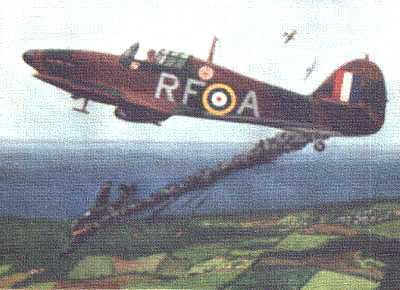This is the story of Polish involvement in this greatest air battle in
history...

First Polish pilots started reaching England in December 1939, following
the British agreement to accept a contingent of 300 Polish aircrew and
2,000 of support personnel. The British were at first reluctant to use
them for operational duties, but after the German invasion of France, in
view of her imminent collapse, the Air Ministry agreed to form two Polish
bomber squadrons, as part of the Royal Air Force Voluntary Reserve. Sir
Hugh Dowding strongly opposed forming Polish fighter squadrons - for which
the Polish government in exile pressed very hard - but in view of rapidly
deteriorating military situation, with Britain's very survival depending
on the Few fighter pilots it could muster, an agreement was finally
reached on August 5, 1940. Four bomber and two fighter squadrons would
be formed. These would formally constitute an independent Polish Air Force,
operationally however they would be under British command.
In the meantime, even more Polish pilots had reached England following
the collapse of France, and in July several of them had already been posted
to British squadrons in the ranks of RAF Voluntary Reserve.
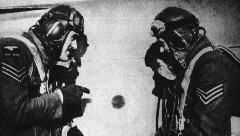 |
Polish pilots of 302 Sqn examine British insignia on their new planes
|
British reluctance to accept Polish aircrew into RAF was understandable,
even though in the end it proved unfounded. John Kent, a Canadian posted
in August 1940 as a flight commander to 303 Squadron later remarked, All
I knew about the Polish Air Force was that it had resisted the Luftwaffe
for about three days. While it wasn't exactly the truth, it was generally
thought that after two lost campaigns (Polish and French) the pilots' morale
must have been low, and their skills remained largely an unknown. Another
important factor was that few of them knew English, so they would be difficult
to incorporate into the British defensive network which relied heavily
on radio communications. But the ever increasing casualties and insufficient
supply of new pilots finally forced the RAF to accept into service foreigners,
of whose Poles were the largest group.

On July 16, first four Polish pilots were posted to British No 145 and
No 253 squadrons. Three days later, Pilot Officer Antoni Ostowicz of 145
Sqn. scored the first victory for Polish pilots in the Battle of Britain,
sharing a
Messerschmitt Bf 110 with a British pilot. Ever since,
the number of pilots fighting in British squadrons steadily increased,
to reach its peak of 73 in October. Victories followed, but so did casualties
- on August 11 Antoni Ostowicz, the same pilot who had scored the opening
victory, became the first casualty, having been meanwhile awarded two more
confirmed kills.
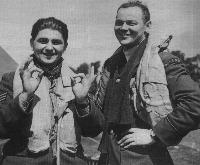 |
F/Sgt Antoni Glowacki and P/O Stefan Witorzenc of 501 Sqn - two of many
Polish Battle of Britain aces
|
During the intensive fighting in August, first Polish aces were made.
Witold Urbanowicz, posted to No 145 Squadron, claimed four victories, and
added thirteen more in September, after being moved to the all-Polish 303
Squadron. Both Boleslaw Wlasnowolski and Karol Pniak scored five victories
in the Battle, but while the former was killed on November 1, the latter
was destined to survive the war. Stanislaw Skalski of 501 Squadron, who
had scored 4.5 victories in the Polish campaign, scored five more in the
Battle, before being shot down and wounded in early September. In the same
501 Squadron, two other Polish pilots became aces - Stefan Witorzenc with
five victories, and Antoni Glowacki, who on August 24 enjoyed a remarkable
success, shooting down no fewer than five German aircraft in one day, for
a total of eight in the Battle. Not everybody shared such luck, though.
Throughout the Battle, a total of 16 Polish pilots flying in British squadrons
were killed, and several others seriously wounded. 11 and 12 August were
especially grim, with five pilots killed in the space of just two days.
On August 18, Franciszek Kozlowski - again of 501 Squadron - was shot down
by German ace Gerhard Schopfel, during his famous sortie when he downed
four Hurricanes without being seen - the infamous British 'vic'
squadron formation was to blame for his success.

Meanwhile, on 15 August, the first all-Polish fighter unit - 302 City
of Poznan Hurricane Squadron based at Leconfield - reached operational
readiness in the No 12 Fighter Group. Flying mostly convoy patrols, the
pilots rarely had a chance to engage in combat, and as a result shot down
only three German bombers until they were moved to Duxford on September
14 as part of the 'Big Wing', led by the indomitable Douglas Bader.
On September 15, the wing was scrambled twice, and for the first time
302 Squadron engaged in large scale combat. While on their first sortie
the pilots got a clean shot at German bombers, on the second they were
engaged by German escorts. Overall, the squadron claimed 11 victories,
at the cost of three Hurricanes and one pilot.
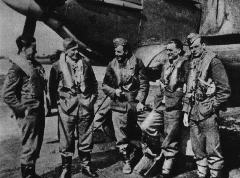 |
'B' Flight of 302 Sqn in readiness, Northolt, October 1940
|
On September 18 the squadron was scrambled three times, and in the last
sortie intercepted a German formation, claiming five victories with no
losses on its part. In the following days the weather deteriorated, and
finally, as enemy activity was losing its intensity, on September 25 the
squadron moved back to Leconfield, to resume its regular duties. It remained
there till October 11, when it was moved to Northolt in place of 303 Sqn.
Any hopes of a significant boost to the squadron's tally were quickly abandoned
however, as the good 'hunting season' was over, with weather getting progressively
worse, and only German Jabo (fighter-bomber) formations appearing
over England. On October 15 the squadron was scrambled to intercept a formation
of about 60
Messerschmitts Bf 109, and in the resulting fight two
Bf 109s were shot down, at the cost of two Hurricanes, with two
other damaged. Throughout that period, however, the weather proved more
dangerous an enemy than the Germans, and five pilots were killed in October
as the result of bad weather conditions. Especially tragic was October
18, when the squadron was scrambled in late afternoon in very difficult
weather, and four pilots crashed into the ground while returning to the
airfield (one of them was a British instructor attached to the squadron).
Overall, during the Battle of Britain, 302 Squadron was awarded 17 confirmed
victories, three of which were scored by British pilots flying with the
squadron.
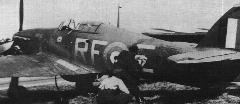 |
A Hurricane of 303 Sqn being patched up after battle
|
The second Polish fighter squadron which took part in the Battle, 303
Kosciuszko
Squadron entered the Battle on August 30, and from the beginning took part
in intensive action. Throughout its stay at Northolt in the 11th Fighter
Group - which bore the brunt of fighting during the Battle - the squadron
achieved phenomenal success. With 125 confirmed victories to its credit,
in the space of mere five weeks it became the top-scoring squadron of the
entire Fighter Command. Please see the 303 Squadron
Battle Diary page for a more detailed look at the squadron's involvement
in the Battle.

When examining the importance of the Polish contribution during the
Battle, the first look, as usual, has to be at the numbers. Overall, 144
Polish pilots took part in the Battle, and scored 201.5 confirmed victories
(17 of which were scored by the famous Czech ace, Josef Frantisek, who
officially was a member of the Polish Air Force). 29 pilots were killed
(including several in accidents), many more or less severely wounded. While
this yields quite an impressive 'kill ratio', in terms of pure numbers
can hardly seem a decisive factor (the entire RAF claimed 2698 'confirmed'
victories). However, the statistics don't tell the most important thing.
It is generally agreed that the single most important factor that could
have lead to British defeat was the shortage of pilots. As the result,
the British were forced to rely on their allies to fill this gap, and Polish
pilots, with their excellent pre-war training and experience from two campaigns
performed beautifully in that role. They were ferocious fighters. With
their homeland in enemy hands and news of Nazi atrocities in the occupied
Poland reaching them on almost daily basis, unsure of the fate of their
close ones, they took their hate into the air with them - as is best testified
in this excerpt from the diary of a German Heinkel pilot (it's also
an interesting snapshot of brain-washed Nazi mentality):
 |
Polish Airmen memorial at Notholt, which served as Polish fighter base
throughout the war
|
Moeller says that Poles are excellent pilots. He's not the first
to say that, others have noticed that too. They're unpredictable, they
fight fiercely like dogs, damned well at that. Moeller says you can feel
in the air how they hate us. Personally, I don't have such feelings towards
them. Why should I? After all, it wasn't us who started the war and, equally
well, they could now be attacking England with us [sic!]. However,
people often don't know what's good for them. Many of them don't even know
why they hate us .
In terms of numbers, in the crucial days of September 1940, every one
in eight pilots of the Fighter Command was a Pole, and 303 Squadron's contribution
was nothing short of amazing. Hence the opinion of Sir Hugh Dowding, cited
at the top of this page.
Nor was the success of Polish fighter pilots lost on the British in
the long run. No more difficulties in expanding the Polish Air Force were
made after the Battle. By the end of 1940, three more fighter squadrons
- No. 306, 307 (night) and 308 were formed, to be joined by No. 315, 316
and 317 in early 1941. By the end of 1943, a total of 14 Polish Squadrons
(ten of them fighter sqns.) and a complete infrastructure were in existence,
making the Polish Air Force the fourth largest Allied air force of the
war. |
